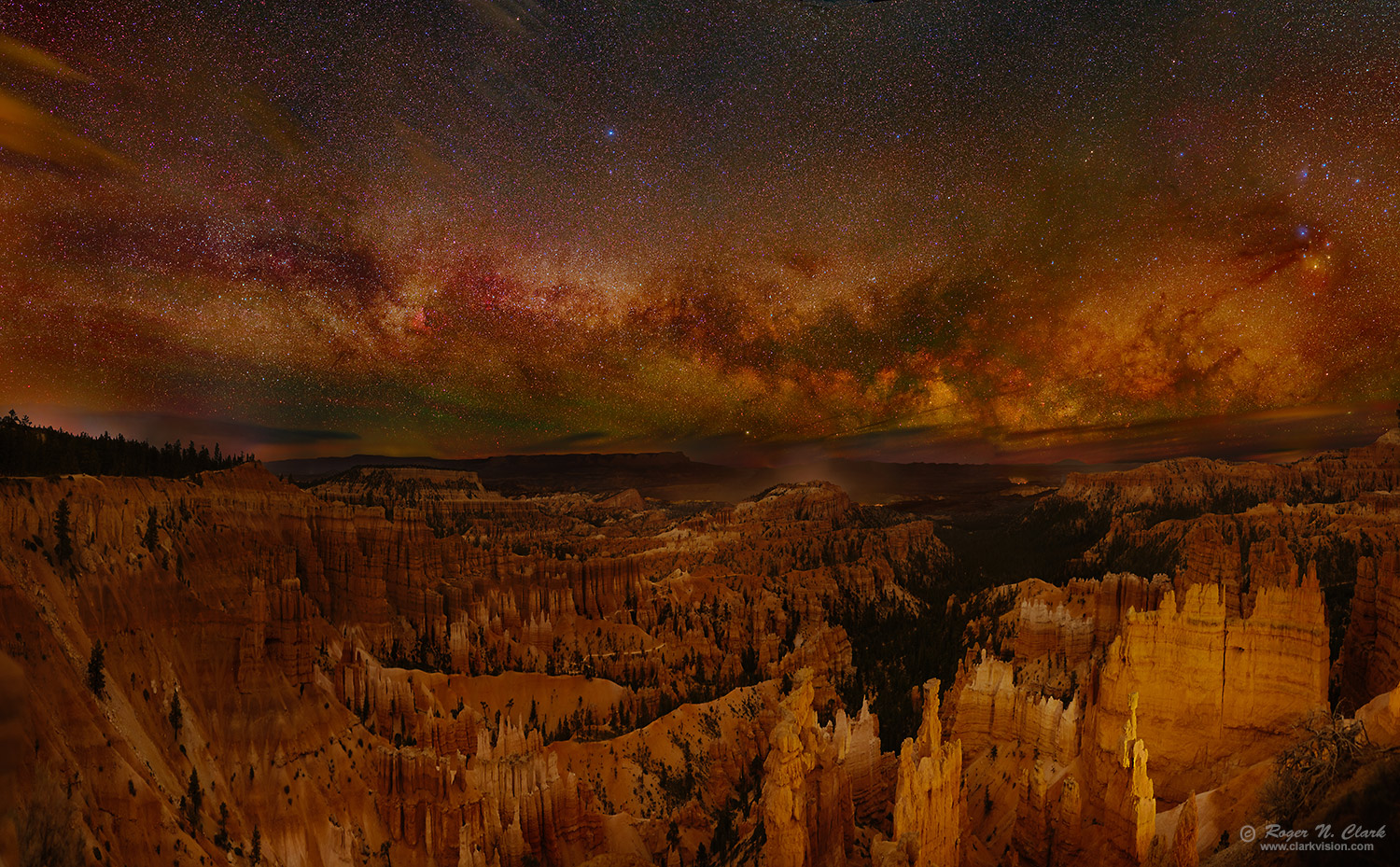| Home | Galleries | Articles | Reviews | Best Gear | New | About | Contact | Gallery Index | Previous |
Next |

| Home | Galleries | Articles | Reviews | Best Gear | New | About | Contact | Gallery Index | Previous |
Next |

The Milky Way rises above Bryce Canyon National Park in Utah, USA, May 07-08, 2020. This is a natural color image with a new (2021) software package that better preserves star color. The stars in the Milky Way are dominantly yellow, orange and red compared to our sun. Interstellar dust is reddish-brown. Mixed in are a sprinkling of blue stars (less than 1% of the stars in our galaxy are blue), pink-red hydrogen emission nebulae, and a rare blue nebula from scattered starlight. Near the horizon is red and green banded airglow from oxygen emission above 90 kilometers in our atmosphere. The airglow shows linear lines from about the 10 o'clock to 4 o'clock position. Dark clouds on the horizon (8 to 2 o'clock position) are approaching and high cirrus (orange clouds) are entering the scene from the upper left. The orange cirrus color is due to light reflected from artificial lights in nearby towns. The glow in the center of the image beyond the farthest Bryce hill is from the town of Tropic, Utah.
Technical. This image was made from a 28-position mosaic in 4 rows involving 63 images. The image was obtained with a Canon EOS R5 Mirrorless Digital Camera and Sigma 35 mm f/1.4 DG HSM lens at f/1.4. The land mosaic was made with 210 second exposures at ISO 1600, one frame per mosaic position and 16 positions in 2 rows. The sky was obtained with 30 second exposures at ISO 800 and 4 to 5 frames stacked for each of the 12 mosaic positions, in 2 rows. The sky frames were tracked. Three sky frames had 2 to 3 frames stacked due to clouds. Total exposure time 1410 seconds (23.5 minutes) on the sky and 3360 seconds (56 minutes) on the land. The land was done first waiting for the galaxy to rise. As soon as the land exposures were finished, the sky images were obtained. Total image exposure time: 79.5 minutes. All mosaic positions were done in landscape camera orientation, as are almost all my mosaics.
The final image is 22164 x 13724 pixels (304 megapixels, 73.9 x 45.7 inch print at 300 ppi).
Post processing:
Raw conversion with rawtherapee to Rec.2020 color space. Stacking with ImagesPlus then mosaicked
with PTGui. After mosaicing, the sky was stretched with
rnc-color-stretch version 1.0. Also see
Astrophotography Image Processing Basic Work Flow.
The land was not stretched-basically out of camera colors with daylight white balance.
The sky stretch used a new feature added to rnc-color-stretch: limiting the
sky histogram zero point derivation to a small part of the dark sky near the top of
the image. This feature is new as of rnc-color-stretch 1.0 (currently in beta testing).
Parameters used for the stretch were:
rnc-color-stretch input_image -rootpower 6 -rootpower2 2 -skylevelfactor 0.008 -obase output_image_name
-histogrambox1 4900 180 20100 3350
The histogrambox1 uses x y coordinates of the upper left corner and lower
right corner of the region to be considered for zero-point derivation.
Accurate zero point is critical to maintaining consistent color from
brightest to darkest objects in the scene. Color balance alone is
not only not adequate, but is a smaller factor than is zero point in
astro photos. It is inaccurate zero point why we see so many Milky Way
photos that fade to fake blue in the outer regions of the Milky Way (that is
not the real color -- the Milky Way is not blue -- such blue is digital art).
This is a natural color image.
The Exposure Factors, CEF, CEFA are measures of the relative amounts of light received from a subject. It can be used to fairly compare wildly different lens/telescope apertures and exposure times. For this image on the sky:
Modern digital cameras like the Canon R5 include on sensor dark current suppression and low fixed pattern noise at ISOs around 800 and higher, making no need for dark frame subtraction. Modern raw converters correct for light fall-off and also correct for hot/dead/stuck pixels. This makes processing low light images easy: simply align and average.
To learn how to obtain stunning images like this, please visit my Extensive Articles on Photography .
Keywords to this image = astrophoto-1 nightscapes airglow landscape-1 night low-light digital_astro utah large_format canon_r5 mosaic bryceNP airglow
Image ID: bryce.canyon-n.p-rclark-.c05.07.2021-4C3A0180-264-h-c1-1500.jpg
| Home | Galleries | Articles | Reviews | Best Gear | Science | New | About | Contact |
Last updated November 03, 2025